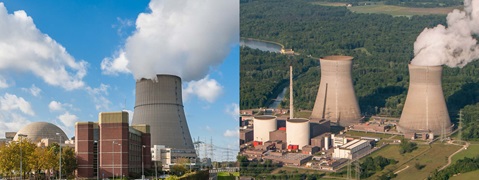The highest degree of safety continues to be a top priority for us when it comes to dismantling our nuclear power plants.
Many regulations that applied during the active operation of our plants remain unchanged. The plants are subject to continuous government supervision based on the necessary licences granted under the Atomic Energy Act and associated regulations. The federal states are responsible for monitoring safety and security of nuclear plants. In most states this responsibility lies with the respective Ministry of the Environment.
Safety principles for our plants
Redundancy and diversity
Our strict “redundancy” and “diversity” principles, ensuring that all safety systems remain operational in the event of interruptions, continue to remain in place during the safe dismantling of the plants. All vital safety-relevant equipment is present several times over and ready for operation, i.e. “redundant”. As is the case with all German reactors, at least two more systems than are needed during normal operation are installed. There are, for example, several separate emergency cooling systems, each with its own power supply.
As a further level of safety, “diversity” means that different physical or construction principles are used in the design of the various redundant systems to ensure that they cannot all fail for the same reason.
Physical separation, fail safe and barrier concept
As an additional safety measure, “physical separation” of facilities prevents several systems being damaged or destroyed for the same reason at the same time, for example by fire or flooding. The fail-safe principle, a methodology that is also employed across all systems, ensures that safety systems kick in as soon as a potential fault occurs. Finally, numerous safety barriers are in place that shield radioactive material inside the nuclear power plant that is being dismantled according to the “onion principle”, i.e. in several layers.
Environmental monitoring
As was the case during power operation, the radioactive discharges from our nuclear power plants are minimal and significantly below the safe legal limits. During the dismantling process, the surroundings of the plant continue to be monitored by the operator as well as independent official bodies. Measured values from the surroundings of the power plant are called up automatically at regular intervals, transmitted by radio and analysed by the authority in charge. The most recent measurement results are available to the public on a permanent basis. The all-year-round use of plant-own environmental measurement vehicles ensures that soil, air and water in the area surrounding the power plant are monitored continuously.
In addition, protecting the population from radioactivity is an important element in the prevention and protection system of the Federal Office for Radiation Protection (BfS). To this end, the BfS operates the Integrated Measuring and Information System for Environmental Radioactivity (IMIS). It continuously monitors environmental radioactivity all over Germany and in all environmental areas. In the event of an accident, it records environmental contamination and forecasts the expected levels of radioactive contamination. The legal basis for this monitoring network is the German Radiation Protection Act.
